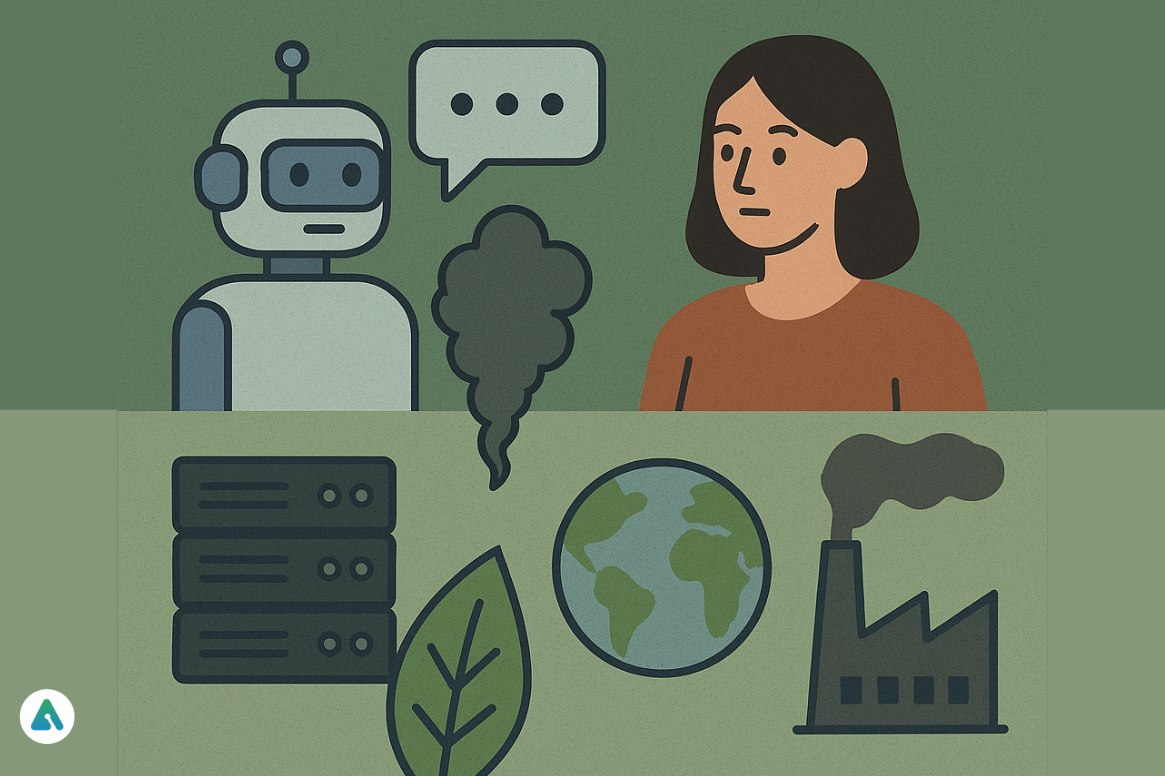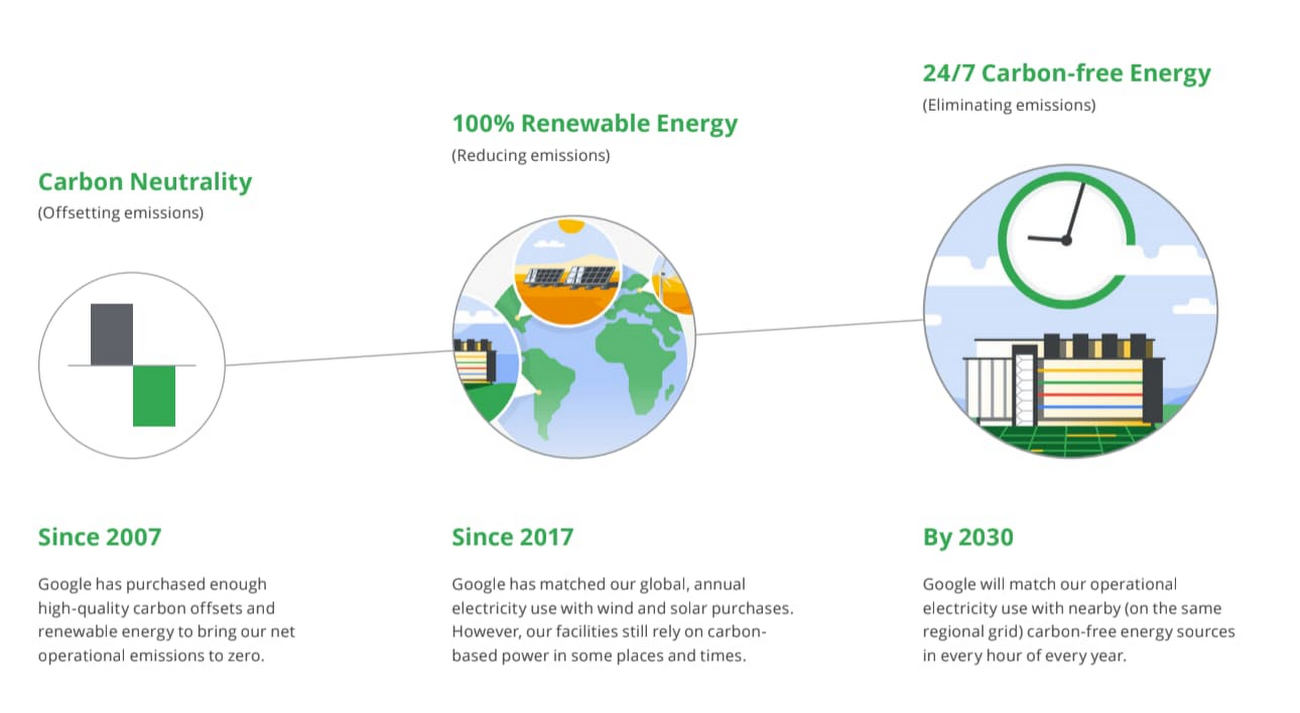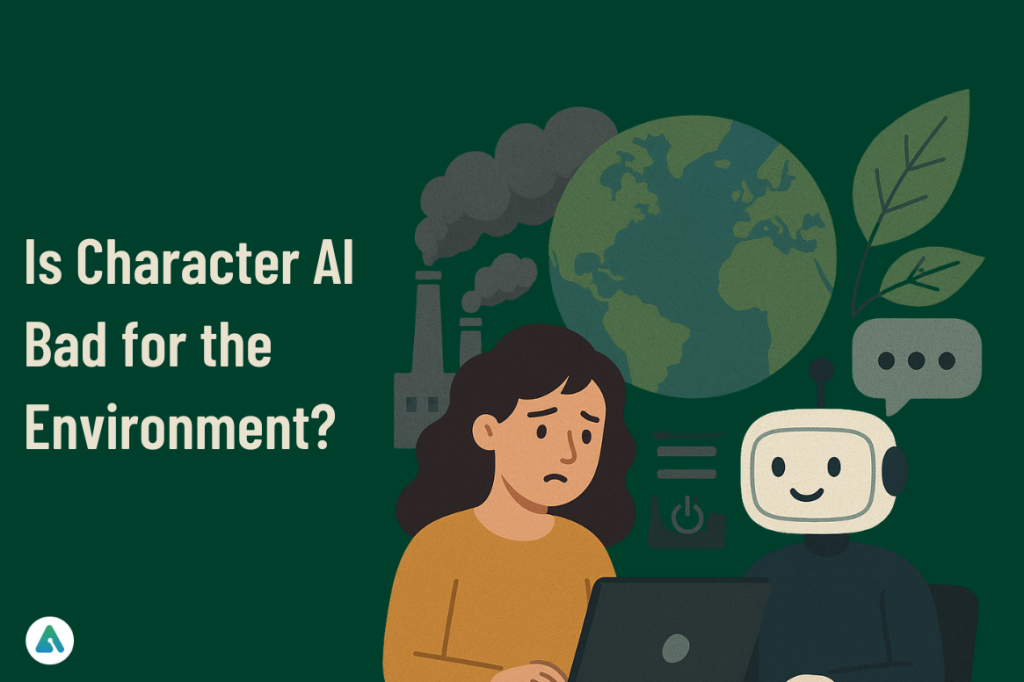Artificial intelligence has rapidly become the invisible engine behind modern life — from streaming recommendations to smart assistants. But as conversational platforms like Character.AI gain millions of users, a critical question has emerged:
Is Character.AI environmentally sustainable — or does our growing reliance on AI companionship come at a hidden ecological cost?
According to recent research, the environmental footprint of AI tools is larger than most users realize. Behind every conversation, gigabytes of data are processed in massive data centers that consume vast amounts of electricity and water. This article examines why Character AI bad for the environment — exploring energy use, carbon emissions, and what the industry is (and isn’t) doing about sustainability.
How AI Chatbots Consume Energy
Every interaction with a large-language-model chatbot, including Character.AI, requires significant computational power.
When a user sends a message, it travels through cloud servers where powerful GPUs process text predictions. This process is repeated millions of times per day, consuming electricity and generating heat that must be offset with extensive cooling systems.
According to a 2019 University of Massachusetts Amherst study, training a large-scale AI model can emit over 626,000 pounds (284 metric tons) of CO₂, roughly equivalent to five cars’ lifetime emissions.
While Character.AI does not publicly disclose its specific model or energy usage, its parent company runs on comparable infrastructure to OpenAI and Anthropic — both of which rely heavily on NVIDIA A100 GPUs and cloud networks hosted by Google Cloud.
| Key Point: The environmental impact doesn’t end at training. Every ongoing chat session continues to draw power from these same servers — meaning even casual daily use contributes incrementally to global data-center energy demand. |
How Much Energy Does a Single AI Chat Use?

A 2024 analysis by Alex de Vries (founder of Digiconomist) estimated that a typical AI text generation consumes between 2.9 and 10 watt-hours per query — about 10 to 30 times higher than a Google search.
If Character.AI hosts over 100 million monthly chats (based on web traffic estimates from SimilarWeb), the cumulative energy draw could reach 500 to 800 megawatt-hours per month — roughly enough to power 25,000 average U.S. homes for a day.
That scale underscores an important reality: while AI conversations feel “lightweight,” the infrastructure behind them isn’t.
(Note: These watt-hour and emission estimates are based on comparable infrastructure benchmarks, not official Character.AI disclosures.)
The Hidden Cost: Data Centers and Water Cooling
Character.AI runs on cloud servers hosted primarily in regions like Oregon, Iowa, and Northern Europe — all major hubs for Google and Amazon Web Services data centers.
These facilities not only require electricity but also immense volumes of water for cooling.
In 2023, The Verge and Bloomberg reported that Google’s data centers used over 5 billion gallons of water annually, primarily for cooling AI servers.
A single AI conversation may indirectly require a few hundred milliliters of water when scaled across millions of queries per day.
For drought-prone regions, this raises serious sustainability questions about where and how AI companies operate.
Comparing AI Platforms: Where Character.AI Stands
| Platform | Reported Monthly Users (as of 2025) | Estimated Power Use per Chat (Wh) | Public Sustainability Policy |
| ChatGPT (OpenAI) | ~246M unique monthly visitors (possibly 700–800M weekly active users) | 3–4 Wh average (8–10 Wh for complex queries) | Partial (Microsoft-backed sustainability initiatives) |
| Character.AI | ~100M unique monthly users (200–223M monthly visits) | 5–9 Wh (industry-consistent estimate) | No public environmental disclosure |
| Anthropic Claude | ~8.2M unique monthly visitors (30M estimated total users across all channels) | 6–10 Wh (plausible estimate) | Google Cloud carbon-offset commitments |
| Meta LLaMA Models | Unknown (open-source, no central user base) | 6–12 Wh (industry estimate) | Meta AI Sustainability Roadmap (2024) |
Figures for Character.AI are approximations based on comparable large-language model infrastructures; actual usage may vary.
Character.AI currently lacks an explicit sustainability or environmental impact statement on its official site, unlike OpenAI and Anthropic, which have publicly discussed offset strategies.
This gap does not mean the company is neglecting the issue — but it does highlight the growing need for transparency in AI energy reporting.
Carbon Footprint: The Real-World Impact
According to the International Energy Agency (IEA) and corroborated by multiple independent analyses cited in the 2024 Stanford University AI Index Report, data centers currently account for approximately 1.5% to 2% of global electricity consumption — a figure projected to double by 2030, largely driven by the accelerating demand for artificial intelligence workloads.
For more on user safety and ethical implications, see Is Character.AI Safe?.
When scaled, Character.AI’s estimated energy usage could generate between 30,000 and 50,000 metric tons of CO₂ per year, depending on grid efficiency. (Again, this is an approximation based on comparable AI model architectures, not a confirmed company figure.) For context, that’s roughly equivalent to the annual emissions of about 10,000 gasoline-powered vehicles.
These figures highlight a growing paradox of convenience: while AI chatbots make digital communication nearly effortless, their environmental footprint remains largely invisible — and increasingly difficult to ignore.
Is Character.AI Doing Anything to Offset Its Impact?
As of October 2025, Character.AI has not released public data on its carbon emissions, renewable-energy use, or offset programs.
However, it relies on Google Cloud Platform, which claims to operate on carbon-neutral infrastructure since 2017 and aims for 100% renewable energy 24/7 by 2030.

That indirectly benefits Character.AI — though it still doesn’t replace the need for direct sustainability commitments.
In contrast, Microsoft (OpenAI’s cloud partner) has pledged to be carbon-negative by 2030, setting a standard for AI accountability that competitors may eventually follow.
The Environmental Trade-Off of AI Companionship
Character.AI’s unique appeal lies in emotional interaction. Millions use it as a digital confidant or creative partner, generating vast volumes of personalized dialogue daily.
Unlike search engines, where users enter short queries, Character.AI’s chats often stretch across hundreds of messages per session, amplifying its computational load.
Each emotionally rich interaction — comfort, storytelling, roleplay — carries a hidden ecological price tag.
While individual usage seems minor, collective behavior shapes enormous backend demand. As users spend more time engaging emotionally with AI characters, global energy systems quietly shoulder the burden.
Can AI Ever Be “Green”?
Experts agree that sustainability in AI depends on three factors:
- Efficient model architecture: Smaller, optimized models like Meta’s LLaMA 3 and OpenAI’s GPT-4o-mini are designed to use less power per query.
- Renewable-powered data centers: Moving computation to facilities running on wind, hydro, or solar power.
- User awareness: Encouraging mindful use — shorter chats, avoiding unnecessary queries, and choosing platforms with public eco-policies.
A 2024 Nature article estimated that transitioning 50% of data-center power to renewables could reduce AI carbon output by over 60 million tons per year — roughly equal to removing 13 million cars from the road.
Sustainability and Ethics: Beyond Carbon
Environmental impact isn’t only about electricity.
AI systems rely on rare-earth minerals, semiconductor manufacturing, and hardware refresh cycles that carry social and ecological costs — from mining conditions to e-waste management.
Each new GPU deployment means new materials, new logistics, and more global energy.
If AI adoption continues without coordinated sustainability standards, experts warn that the environmental gains made by clean-tech industries could be undermined by digital expansion.
What Users Can Do
While users can’t directly change Character.AI’s infrastructure, individual choices matter:
- Limit unnecessary chats and long-running roleplays that consume compute cycles.
- Support renewable energy projects or browser extensions that offset online carbon use.
- Advocate for transparency — ask platforms to disclose environmental data and sustainability goals.
- Educate others about digital carbon footprints, especially young users unaware of the invisible energy behind AI.
Every message adds up — and awareness is the first step toward responsible AI use.
FAQs
Q. Is Character AI bad for the environment?
Character.AI itself is not uniquely harmful compared to other AI chatbots, but its operations contribute to the growing energy and water consumption of global data centers. The lack of transparent sustainability reporting remains a key issue.
Q. Does Character.AI use renewable energy?
A. Character.AI hosts its systems on Google Cloud, which claims carbon-neutral operations since 2017 and a 100% renewable goal by 2030. However, the company has not published its own environmental data.
Q. How much carbon does AI produce?
A. Training a single large-language model can emit hundreds of tons of CO₂, and each query can use up to 10 watt-hours of electricity. The AI industry’s total emissions could rival that of major nations by the next decade if growth continues unchecked.
Q. Can AI be sustainable?
A. Yes — through smaller, more efficient models, renewable data centers, and responsible use. But that requires both corporate commitment and user awareness.
Final Thoughts
Character.AI represents the emotional frontier of artificial intelligence — one that humanizes technology but also magnifies its hidden costs.
Every comforting chat or creative story is powered by vast electrical networks, cooled by water systems, and sustained by rare hardware resources.
According to data from Stanford University, Digiconomist, and Google Cloud, AI sustainability remains one of the decade’s defining challenges.
Character.AI’s popularity highlights why environmental transparency can no longer be optional for AI companies — it must become an ethical standard.
The bottom line?
AI companionship is powerful, but responsibility must evolve alongside innovation.
Because the future of human-AI relationships shouldn’t just be emotionally intelligent — it should also be environmentally conscious.
Visit: AIInsightsNews


